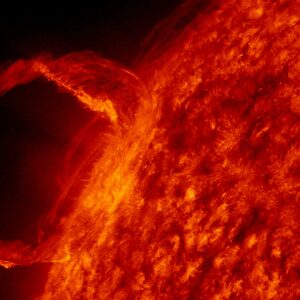The National Aeronautical Space Association (NASA) was puzzled when the scientists discovered a piece of the Sun’s surface breaking off creating a vortex.
The amazing footage of the moment was captured by Nasa that showed a tornado-esc swirling around its North Pole.
Meanwhile, scientists are figuring out what effects it will have on Earth after a huge portion of solar plasma got separated from the surface of the sun.

AFP/Getty Images)
On the other hand, a space weather forecaster, Dr. Tamitha Skov tweeted on the footage that got viral on social media saying, “Talk about Polar Vortex!
“Material from a northern prominence just broke away from the main filament & is now circulating in a massive polar vortex around the north pole of our Star.
“Implications for understanding the Sun’s atmospheric dynamics above 55° here cannot be overstated!”
According to experts, the incident is receiving massive comments from all over the world because this separation usually happens once every 11-year solar cycle, when the sun reaches 55-degree latitudes.
In a subsequent tweet, the forecaster added: “More observations of the #SolarPolarVortex reveal it took roughly 8 hours for material to circumnavigate the pole at approximately 60 degree latitude.
“This means an upper bound in the estimation of horizontal wind speed in this event is 96 kilometers per second or 60 miles a second!”
However, experts are left with no clue why such an incident happened at this point as stated by the deputy director at the National Center for Atmospheric Research in Colorado, Scott McIntosh who is a solar physicist.
He told Space.com: “Once every solar cycle, it forms at the 55-degree latitude and it starts to march up to the solar poles.
“It’s very curious. There is a big ‘why’ question around it. Why does it only move toward the pole one time and then disappear and then come back, magically, three or four years later in exactly the same region?”
According to some researchers who believed that this event is so far related to the sun’s magnetic field, nothing can be said for now due to the finite picture of its star.
For now, scientists can look at the sun from the “ecliptic plane”, also called the geometric plane that covers the orbit of the planet earth.
But there’s still hope as the European Space Agency’s Solar Orbiter mission captures photographs of the sun that have raised its orbit above the ecliptic plane, so the team can help to put up some light on this event.
However, until the experts mark the incident properly nothing can be said.











